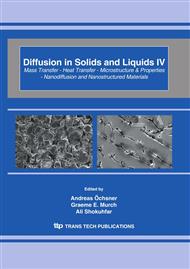p.565
p.571
p.577
p.583
p.589
p.594
p.599
p.604
p.610
Heat and Mass Transport in the Unsaturated Porous Media: Application to the Soil Dry Drainage Method
Abstract:
Salinity currently has the highest priority of all environmental issues nowadays. The only means of preventing the development of soil salinity was combining leaching and artificial drainage. Recently a new method of capturing and removing salt from the soil surface called a dry drainage method [1-4] has been studied (fig.1) to help arid soils prevention against such threat. This work is a numerical simulation of the simultaneous water, solute and heat transfer in an unsaturated porous media during the simultaneous evaporation and drainage of saline dry land soils. A detailed mathematical model was formulated to describe the non-isothermal transport of water in the unsaturated porous media [5]. The model consists of the coupled conservative equations of mass for liquid phase, gas phase, water vapour, species and the energy. The boundary conditions at the soil–atmosphere interface include dynamical mass flux and energy flux. Comparison of numerical simulations with analytical results demonstrated that the present model is able to describe water and energy transport dynamics.
Info:
Periodical:
Pages:
589-593
Citation:
Online since:
March 2009
Authors:
Price:
Сopyright:
© 2009 Trans Tech Publications Ltd. All Rights Reserved
Share:
Citation:


